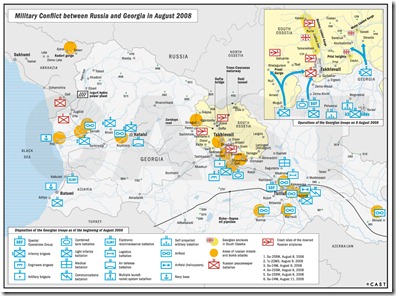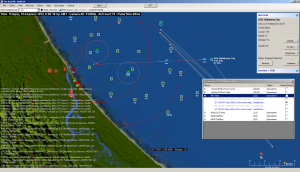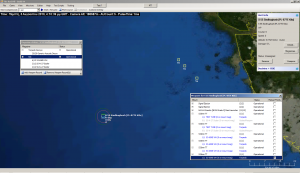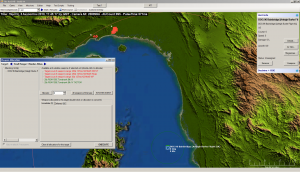Georgian War report: “The Tanks of August”
 The Center for Analysis of Strategies & Technologies, a Moscow-based think tank, has published a comprehensive report on the 2008 conflict in Georgia, aptly named “The Tanks of August”.
The Center for Analysis of Strategies & Technologies, a Moscow-based think tank, has published a comprehensive report on the 2008 conflict in Georgia, aptly named “The Tanks of August”.
According to the report’s description:
The first essay looks into the transformation of the Georgian armed forces under President Mikhail Saakashvili and details Tbilisi’s key preparations for the war.
The second and central essay offers a detailed timeline of the hostilities. It draws on a wide range of sources, from official chronicles and statements to recollections of the eyewitnesses on both sides and Internet reports. The timeline contains detailed descriptions of all the key combat operations and episodes during the war.
The third essay analyses Georgia’s efforts to rebuild its military machine since August 2008, as well as the existing military situation and the balance of power in the region.
The four remaining chapters look into several individual aspects of the Five Day War, including combat losses on both sides, Russian aviation losses, and the post-war deployment of Russian military bases in Abkhazia and South Ossetia, now recognized by Moscow as independent states.
The Annex details in chart form Georgia’s procurement of heavy arms and military equipment in 2000-2008.
The report can be freely downloaded from the CAST website, here.
Red Pill screenshots #8: Choose your weapons
Time has flowed since our last update on the development of Red Pill, and things have moved forward on multiple fronts. We are currently integrating an improved ESM model, a brand-new jamming model (hint: no paper rules to conform to), a new sonar model, a new relief map layer, a high-resolution coastline layer, improved guidance for datalinked weapons, much improved weapon endgame calculations including generation-based seeker-vs-countermeasure/decoy comparison and lots more.
For the moment, though, let us look into some of the weaponry management features present.
In this example, a US destroyer has taken station in the entrance to the Hormuz straights and is preparing to attack the airfield & related facilities at Bandar Abbas. (Click to enlarge)
In addition to enabling a unit to engage targets freely on its own, Red Pill offers a manual weapon assignment window, similar to those found in legacy wargames. We have already mentioned that Red Pill allows the modeling of installations as large complexes of discrete facilities instead of monolithic units, so in this case the player can choose in detail which structures of the airbase to attack, and optimally match available weapons to targets (e.g. Tomahawks with penetrator warheads to the most heavily-armored shelters).
One of the most important improvements in this functionality is the ability to create so-called “Deferred” weapon allocations.
A deferred allocation is one that cannot be executed at the moment (for any number of reasons, for example if the target is currently out of range for that weapon), but will trigger automatically once the launch conditions are met. In this case, we can instruct the US destroyer to attack the facilities at Bandar Abbas either with its Tomahawk missiles or using its main gun. In the former case, the attack can be executed immediately (but not necessarily; see below). In the latter case, the gun rounds assigned for the attack will be fired once the destroyer gets within range of the targets.
Deferred weapon allocations are particularly useful for planning coordinated attacks, as they allow precise per-unit target distribution and weapons assignment: Instead of simply directing an F-16 flight to attack a surface group and hope they do their best (which works too, BTW), you can instruct Falcon #1 to fire two HARMs at the cruiser, Falcon #2 & #3 to engage the two destroyers with Harpoons, and Falcon #4, #5 & #6 to follow-up with LGB attacks on the smalller ships. In legacy wargames, such targeting flexibility was available only to human players and only once the attacking units were within weapons release parameters; Red Pill gives this ability to human and AI-controlled sides equally, and makes it available at any point in the scenario, from the initial strike planning all the way to weapons release.
Deferred allocations also have two other abilities that currently exist in code but are not yet supported by the UI (they will be, at a later point):
- The ability to specify a Time-On-Target (TOT) value. The “staff AI” will then adjust the launch time of the weapons so that they arrive at the target at the specified TOT.
- The ability to define a plotted course for the weapons (only for weapons that support waypoints). Combined with the TOT functionality, this enables an extremely comprehensive attack plan that can overcome even highly capable defences.

This is a shot from “Battle of Dong Hoi”, a scenario based on the like-named confrontation of the Vietnam war. The cruiser Oklahoma City is engaging incoming MiG-17s with her Talos missiles, and we have opened the Weapons window to observe how the crew is reloading the missile launcher. Notice the tick-mark on the “Reload Priority” column, for the RiM-8G weapon. This specifies that we explicitly instruct the crew to give priority to this weapon when reloading.
In legacy air/naval wargames, reloading the desired weapon in a multi-weapon mount/launcher can be a chore. If the AI crew happens to load the weapon you actually want, you are in luck. If they don’t, you have to be constantly on your toes and manually load the desired weapon each and every time the mount is available for reload, swapping out the undesired already-loaded weapon(s) if necessary. This can range from annoying (missiles) to a downright infuriating clickfest (gun rounds, particularly on small/medium calibers). The need for constant manual intervention also means that the AI (friendly and enemy alike), if left on its own, is likely to make some very stupid weapon choices for the given tactical situation.
Red Pill overcomes this serious problem with a two-pronged approach: smarter AI-managed weapons reloading, and explicit reload priority.
The “AI crew” in Red Pill considers carefully which weapon to load on a mount given the tactical situation and the unit’s primary target/threat. It attempts to decide the most suitable weapon for the desired target and loads this weapon if possible. The factors affecting the suitability of weapon for a target are numerous: the target’s type, its physical size vs. the weapon’s accuracy, its armor level (if identified) vs. the weapon’s warhead & fuzing type, its speed and maneuverability, whether it is within launch range for the given weapon etc. As an example, airburst gun rounds and missiles fitted with fragmentation warheads are an excellent weapon against air/missile targets and small, fast surface craft (like pirate dhows, for instance) but a poor choice against armored warships or land facilities.
The explicit reload priority feature is useful in cases where the player (or scenario author, arranging AI-controlled forces) wishes to override the reload decisions of the AI crew and maintain a specific weapon loaded on a mount. This includes unloading non-priority weapons and swapping them with prioritized ones if necessary. Once the preferred weapon is no longer available, the crew will load non-priority weapons on its own as usual. Multiple weapons per mount can be designated for reload priority; in this case the crew attempts to balance their quantities on the mount. In the above example, we could have tick-marked both the RIM-8G and the RIM-8J version of the Talos, and the crew would strive to keep one of each loaded on the rail launcher.
Let us look at a practical example where these features are combined, and their benefit:

Here we have an Indian Kilo-class submarine and three unknown surface contacts. The Kilo has a mixed torpedo loadout at the moment, two wake-homers (suitable only for surface ships) and four dual-purpose torps. Notice that we have specified one of the dual-purpose torpedoes to have reload priority on the last torpedo tube; this is to ensure that the sub always has a snapshot counter-fire capability if it detects an incoming torpedo or enemy vessel at close range.
Now if we direct the sub to attack any of the three surface ships, the AI crew will swap out the dual-purpose torpedoes (EXCEPT the one we specified as having priority!) and load dedicated anti-surface weapons in their place: Wake-homing torpedoes and SS-N-27 cruise missiles. If the tactical situation changes and an enemy submarine becomes the primary concern, the crew will swap out any anti-surface weapons from the tubes and reload with dual-purpose or ASW-only weapons.
In conclusion, the new weaponry management features in Red Pill lead to both significantly less micromanagement for the human player’s forces (goodbye clickfests), and a much more capable AI-controlled adversary that exploits his weapons to the full.






